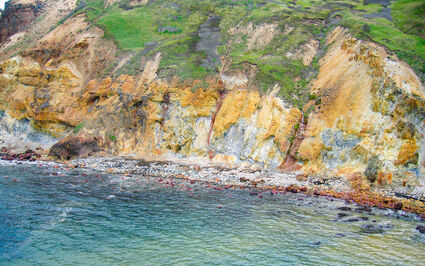Earthquake does not shake Unga drilling
Lack of workers, however, slows start to fall drill program North of 60 Mining News – October 23, 2020
Last updated 11/5/2020 at 6:49am

Heliostar Metals Ltd.
The Aquila target at the southwest end of the Shumagin trend on Heliostar's Unga gold project on the Alaska Peninsula.
Heliostar Metals Ltd. (formerly Redstar Gold Corp.) said the Oct. 19 magnitude 7.5 earthquake with an epicenter about 45 miles south of Unga Island did not have any major impacts on its gold exploration there. The originally planned 6,500- to 8,000-meter drill program, however, has been slowed by a dearth of drillers.
"The ramp-up of our drilling program has been slower than planned due to difficulty staffing the three contract rigs at site," said Heliostar Metals CEO Charles Funk. "However, we are now making more significant progress with 1,200 meters completed and a total of 12 holes complete across the SH-1, Apollo and Aquila targets."
Funk, founder and former president of Heliodor Metals, took over as president of Heliostar following Redstar's August acquisition of Heliodor, an exploration company with interests in three epithermal gold and silver projects in Mexico.
In September, the merged company launched the 2020 drill program testing four priority target areas at Unga – SH-1, Apollo Mine, Aquila, and Centennial.
SH-1, the most advanced target at Unga, hosts 866,015 metric tons of inferred resource averaging 13.8 g/t (384,318 oz) gold and 35.4 g/t (986,321 g/t) silver, according to an inaugural resource calculated earlier this year.
So far this year, Heliostar has completed 743 meters of drilling in eight holes at SH-1. This drilling has focused on the up-dip extensions of mineralization, in a roughly 100-meter gap between historical drilling and the surface and the down-dip extensions of mineralization at or below historical drilling levels.
Heliostar said the up-dip drilling encountered veining and hydrothermal breccia in all eight completed holes and will serve to improve near surface estimations of geometry and grade. One hole targeting the down-dip extensions of mineralization encountered veining and hydrothermal brecciation.
The company has also completed a 199-meter hole at Apollo, home to Alaska's first hardrock gold mine.
The adjacent Apollo and Sitka mines produced roughly 150,000 oz of gold from high-grade epithermal veins from 1886 until they were shuttered in 1922.
Heliostar said its hole targeted gold mineralization at the lower margins of the historic mine and encountered hanging wall veins and workings. A second drill hole targeting the down dip projection of the historic stopes at a lower elevation than the first is in progress.
Historic gold mining occurred over the upper 200 vertical meters of the system but did not progress deeper due to a change from a gold dominant oxidized mineralogy to a gold, silver, base metal-rich unoxidized mineralogy which could not be profitably processed using methods available at the time.
This year's drill program is the first to intersect the downdip projection of these historically mined ore shoots.
Heliostar has also completed 258 meters in three holes at the Aquila target at the southwest end of the Shumigan Trend, a six-mile-long corridor running across Unga Island that also hosts SH-1.
The company said two of the holes drilled at Aquilla intersected the targeted vein, which was discovered by Battle Mountain Gold in the 1980s. Drilling of the vein at that time was unsuccessful and abandoned in large part due to poor core recoveries. Heliostar said the current drill program has been more successful with significantly better core recovery in the first holes of this program.
Assay lab turnaround times are slow, and results are pending from all holes drilled at Unga this year.
"Veins have been intersected in drilling at each prospect and the company has submitted samples for analysis with an expectation of first results during November," said Funk.
The program is expected to continue until late-November but Heliostar does not anticipate reaching its original drill meterage due to the slow start to the program.















Reader Comments(0)